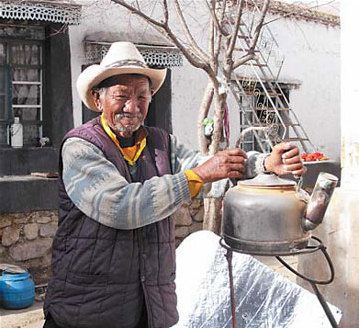|

Tibet resident Kerong boils a pot of water via a solar energy facility in his courtyard last week. [China Daily/By Hu Yinan]
|
Contrary to what many believed and as cases such as Kerong's have shown, religion was never the sole force that advocated the tens of thousands of Tibetan serfs and beggars to "voluntarily" observe the laws of karma that bound them to such servitude.
Instead, a wide-ranging network of control was known to have been at play to tie the Tralpas and Duiqoins - serfs with a lower status and lesser land allocation than the Tralpas - to their limited share of land, and rule the Nangzan, or household slaves, through sheer violence.
All these groups were known to have been at the mercy of not more than 200 wealthy families and a handful of powerful temples. Kerong himself was only one of 25,000 serfs at the Drepung, which controlled 185 manors, 300 major pastures and 16,000 herdsmen in the 1950s.
"Every society progresses, but not the Old Tibet then," said Salung Phunlha, deputy chief of the influential Tashilhunpo Monastery in Xigaze, Bailang county. "Ordinary people had to pay heavy taxes if they wanted to visit monasteries. Not many people had that luxury. Beggars were everywhere."
Salung entered the monastery aged 9 in 1951 and toiled for the senior lamas for nearly a decade. "Nobody cared, not even if you fell down and died from exhaustion," he said.
"That was the life of all serfs before 1959, not for one year, but for hundreds and thousands of years.
"You were a damned slave."
Like all the slaves in Tibet, Kerong suffered in the monastery. But he did not know where, or who to turn to. No one knew the true name of their master - it could have been a wealthy north Tibetan lama who earned the nickname "Apota", or "the Big Tiger", among Drepung's serfs.
"My parents, two elder sisters, wife and I lived in a low, damp and dark room measured out by a pole (about 20 sq m)," Kerong said. "We were all Tralpas; my mother and sisters were slaves carrying out transportation tasks for the monastery."
Yeshe Lodro was born to share Kerong's fate, but his mother was too poor to raise him. He was sent to Drepung by a local lama when he was 2. Three years later, Yeshe became a monk and, like Salung and most other young monks, became servants to a senior lama.
"My biggest hope as a child was not to be beaten and scolded. But it was futile," he said. "I could deal with the scolding, but I could only take so many beatings."
"I couldn't possibly live in the monastery," Yeshe said. "I had to escape."

